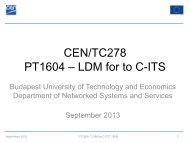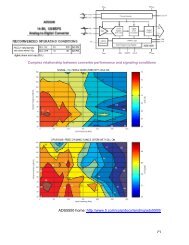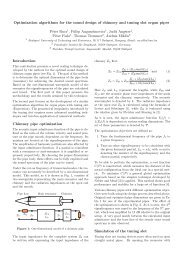HP 33120A User's Guide
HP 33120A User's Guide
HP 33120A User's Guide
You also want an ePaper? Increase the reach of your titles
YUMPU automatically turns print PDFs into web optimized ePapers that Google loves.
Chapter 7 Tutorial<br />
Modulation<br />
For triggered burst operation, the function generator creates an internal<br />
modulation signal which is exactly synchronous with the carrier waveform.<br />
This internal modulation signal is used to halt waveform memory<br />
addressing when the last data point is reached. This modulation signal<br />
effectively “gates” the output “on” and “off” for the specified number of<br />
carrier wave cycles. The modulation signal is then triggered by another<br />
internal burst rate signal generator which controls how often the<br />
specified carrier burst is output. In external triggered burst operation,<br />
the modulation signal trigger source is set to the function generator’s<br />
rear-panel Ext Trig terminal. This source replaces the internal burst<br />
rate signal generator for pacing triggered bursts.<br />
Changes to the burst count, burst rate, burst phase, or carrier frequency<br />
will cause the function generator to automatically compute a new<br />
modulation signal and download it into modulation RAM. It is not<br />
possible for the function generator to burst single cycles for all carrier<br />
frequencies because the internal modulation signal generator is not as<br />
capable as the main carrier signal generator. The table below shows the<br />
function generator’s carrier frequency and burst count limitations.<br />
Carrier<br />
Frequency<br />
10 mHz to 1 MHz<br />
>1 MHz to 2 MHz<br />
>2 MHz to 3 MHz<br />
>3 MHz to 4 MHz<br />
>4 MHz to 5 MHz<br />
Minimum<br />
Burst Count<br />
1<br />
2<br />
3<br />
4<br />
5<br />
For sine, square, and<br />
arbitrary waveforms only.<br />
292
















